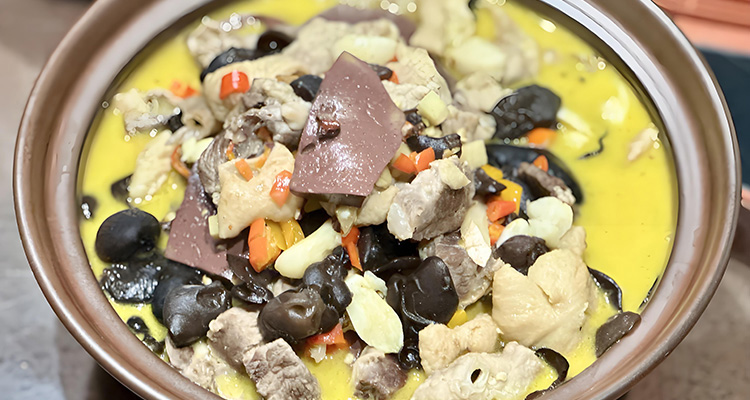Northeast Pork Feast: A Winter Dongbei Celebration
1. Origin and Cultural Roots of the Northeast Pork Feast
Imagine a frozen winter in Northeast China. You sit around a warm kang bed, and a big pot of steaming Northeast Pork Feast is served. The tang of sauerkraut and savory pork blend, the blood sausage burst with smoothness, and with each bite, warmth spreads from your stomach to your whole body. This is Dongbei cuisine at its most generous.
This pork feast started in rural Northeast villages. In old times, farmers slaughtered pigs in winter. Families made this dish to celebrate harvest and reunion. It dates back to the Qing Dynasty and has centuries of history. It is central to the “kill the pig” ritual in farm culture. It shows how rural Chinese share food and joy.
For people in the Northeast, this dish is more than food. It symbolizes connection, warmth, and bold hospitality. On cold winter days, families or neighbors sit around a table and share this stew. It means unity, welcome, and deep affection. It’s a staple at festivals and major gatherings—a farmhouse feast that carries blessings.

2. Ingredients, Flavor, and Cooking Tips of the Pork Stew
Ingredients Description
The feast uses simple but authentic ingredients: fresh pork (belly, bones, and pork blood), local sauerkraut (fermented Chinese cabbage), and blood sausage (blood mixed with starch in casing). The sauerkraut’s tang balances pork fat. The blood sausage adds silky texture. All together, the dish is rustic and deeply nourishing.
How to Cook This Hearty Pork Hotpot
Traditionally, you put pork and sauerkraut in a big iron pot. Add water, salt, and simple seasonings. Simmer on low heat for 2 to 3 hours. The blood sausage is cooked separately at first, then added to the pot. You watch the heat carefully until pork is tender, sauerkraut fully infused, and the broth is rich. Right before serving, sprinkle chopped scallion. The aroma will fill the room.
Flavor & Texture Experience
This Chinese winter stew has a bold, mellow taste. The tartness from sauerkraut fuses with the pork’s richness. Blood sausage is silky and chewy. The broth is savory, sour, and appetizing. It tastes heavy but never greasy. You’ll feel warm from inside out. Each spoonful reveals the spirit of rural China’s generosity.

3. Serving, Tips & Where to Try It in the Northeast
How to Eat It
The authentic way is to ladle a large bowl of the stew. Serve with steamed rice or cornbread (maize pancake). In the Northeast, people sit together, chat, and eat slowly. You may dip slices into garlic sauce or chili paste. Blood sausage and sauerkraut are key highlights. Don’t forget to sip hot broth—the best part.
Where to Taste Authentic Version
You can find the real Northeast Chinese pork feast in rural guesthouses in Jilin’s Changbai or Harbin’s countryside. Or try heritage restaurants like “Old Chang Spring Pancake” or “Northeast Family.” Expect spending about ¥50–100 per person. When ordering, ask for “kill-pig stew (杀猪菜)” — it usually includes blood sausage and sauerkraut. Winter is the best season to visit—the ingredients are freshest.
Tips for Tourists & Home Cooking
The English name is “Northeast Chinese Pork Feast.” Best season is winter (November to February). You can also add local cold dishes like smashed cucumber or steamed buns to complete the meal. Dress warmly and enjoy the full winter ambiance.
At home, you can make a simple version. Use supermarket pork belly and jar sauerkraut. Simmer for 1–2 hours (use a pressure cooker to cut to 30 minutes). Add blood sausage or substitute with regular sausage. Season with salt and pepper. It won’t be as rustic but very satisfying with rice.
So go ahead—try this Dongbei pork feast in your journey. It’s more than a dish; it’s a cultural experience. Let this steaming pot become your memory of Northeast warmth and spirit.


